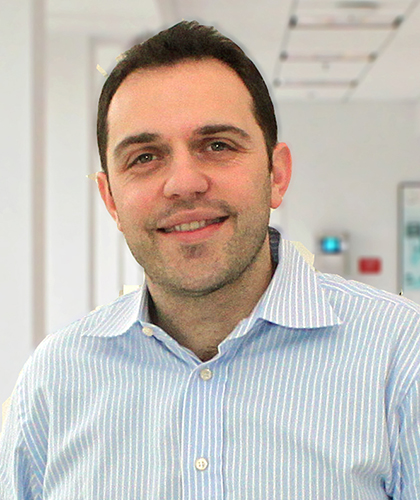Scarcelli Promoted to Full Professor, Appointed CTEM Co-Director and Named St. John Professor
On July 1, 2025, Fischell Department of Bioengineering faculty member and Fischell Institute Fellow at the Robert E. Fischell Institute for Biomedical Devices, Giuliano Scarcelli, was promoted to the rank of Professor. Scarcelli was also recently appointed as Co-Director of the Edward & Jennifer St. John Center for Translational Engineering and Medicine (CTEM) and named an inaugural recipient of the Edward and Jennifer St. John Professorship in Bioengineering. “Giuliano’s promotion and his appointment to these prestigious leadership roles are a testament to his outstanding expertise and vision,” says Distinguished University Professor and Department Chair John P. Fisher. “We’re excited to work with him as CTEM continues to grow and build impactful connections between engineering and clinical practice.” The Edward and Jennifer St. John Professorship recognizes faculty whose research exemplifies the mission at CTEM. Established to promote visionary leadership at the intersection of engineering and clinical practice, the professorship provides strategic support to advance high-impact scholarship, foster cross-disciplinary collaboration, and accelerate the translation of research into real-world applications. “The Fischell Institute has been one of College Park’s best success stories in merging engineering innovation with biomedical application,” Scarcelli says. “That success helped inspire my vision for the center.” Scarcelli will lead CTEM alongside Dr. Osamah J. Saeedi, Professor of Ophthalmology and Visual Sciences at the University of Maryland School of Medicine. CTEM was established through a landmark $10 million gift from Edward and Jennifer St. John and the Edward St. John Foundation. The center brings together researchers from the College Park and Baltimore campuses to develop engineering-based solutions for urgent clinical needs. "This is a new initiative that should finally close the gap between engineering and medicine. It feels great to help implement it from the ground up.” Scarcelli says. “Once that foundation is in place, the sky’s the limit. This opportunity to focus on translational work with direct clinical impact is what I’m most excited about." Scarcelli joined BIOE in 2015 and leads the Optics Biotech Lab. His group develops new optical tools to study physical properties of biological tissue, such as stiffness and viscosity, which are difficult to measure with conventional methods. Scarcelli is widely recognized for his role in creating Brillouin microscopy, a non-invasive imaging method now used in labs around the world. With a foundation in optical physics, the team designs advanced instruments and imaging tools to study tissue properties such as mass, stiffness, and viscosity. These measurements are often difficult or impossible with conventional techniques but are critical to biomedical applications. Most recently, his lab participated in an international consensus published in Nature Photonics that established reporting standards for Brillouin microscopy, a powerful and non-invasive imaging method. "I’ve been lucky to work with an amazing group. Postdocs, graduate students, and colleagues have all contributed to the success of our lab. The department and Fischell Institute have been a great home for our work." Scarcelli has received numerous honors, including the NIH Quantitative Career Award, the National Science Foundation CAREER Award, the Human Frontier Science Program Young Investigator Award, the Tosteson Postdoctoral Fellowship at Harvard, and teaching excellence awards from both Harvard and Maryland.
Related Articles: August 5, 2025 Prev Next |
|


